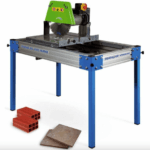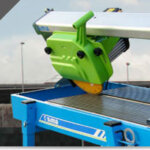First off, what is a masonry bench saw, and what are they used for? These machines are one of the most important tools for professionals who work with brick, tile, stone, concrete, granite, marble and other similar materials. They are basically just a standard table saw or bench saw with a sturdy, stainless steel frame and a special saw that is designed to cut stone-like materials, such as those listed above, using a diamond blade with flowing water as a lubricant and coolant.
There are two basic designs for a masonry bench saw: the first has a sliding table and a stationary cutting head (you slide the material into the blade, e.g. when cutting tile), and the second has a sturdy table that doesn’t move with a moving cutting head (you slide the blade into the material, e.g. when cutting a bulky granite slab).
Different models of masonry bench saws may vary in how heavy or portable the table portion is; some are designed to be lightweight and easy to move to different job sites, while others are heavier and designed for shop use.
Before cutting with your masonry bench saw
Before doing anything, you need to ensure that you have the proper safety equipment to safely cut with your masonry saw. This includes eye protection, ear protection, steel-toe boots, and snug fitting clothing. Tie back loose hair and avoid wearing dangling jewelry. Head protection, gloves and a respirator mask are also recommended. Note: respirator masks are mandatory for dry cutting.
If you will be wet cutting (which is the safest way to cut and the best for your blade), ensure that the water pump is working and has access to an adequate water source. Check the diamond blade to see if it’s appropriate for the material you will be cutting and to ensure it isn’t warped, chipped or damaged, and make sure it is correctly mounted on the machine. Note: special blades are required for dry cutting – dry blades can be used wet, but wet blades cannot be used dry. Also check the oil levels in the motor and install any available safety mechanisms, like blade guards, that came with your model.
If you will be cutting dry, block off the area and any vents with plastic sheeting and wear a high quality respirator mask. The dust produced by cutting stone-like materials contains very dangerous micro-crystalline silica, which can cause permanent lung damage.
Using your masonry bench saw
After measuring and marking the materials you need to cut, connect the masonry bench saw to a power source (if electric) and turn on the motor and water pump. Confirm that water is flowing freely over the blade and that the blade isn’t making strange noises or vibrations.
If everything is working correctly, begin cutting the material slowly, either by sliding it into the blade or by moving the blade, depending on your machine. In both cases, it’s important not to apply too much force; let the saw determine the cutting speed, and just help guide it through the material. Make sure you have lined the blade up on the cutting line perfectly before starting, as you won’t be able to “steer” to correct a crooked alignment. Exerting sideways pressure is very dangerous and can severely damage your blade.
Always turn the masonry saw off after each cut and whenever it’s not in use.





